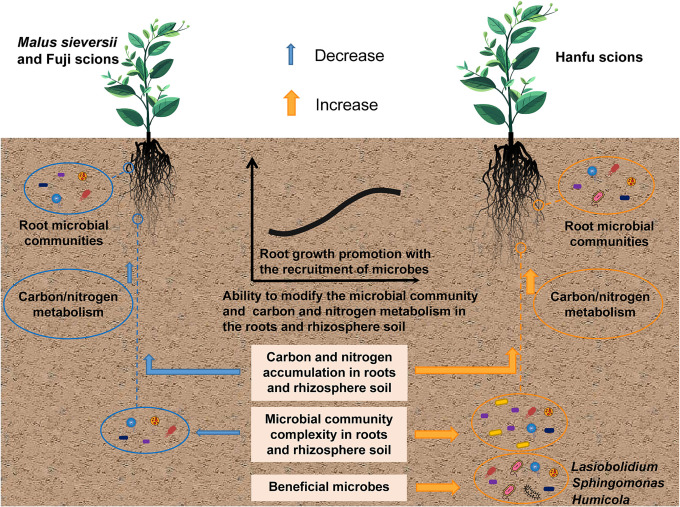Effect of grafted scion varieties on apple root growth, carbon and nitrogen metabolism and microbiome in roots and rhizosphere soil
文章信息:Huanhuan Zhang, Dongdong Yao, Guangxin Zhang, Hossam Salah Mahmoud Ali, Xujiao Li, Yanshu Li, Tianqiang Liang, Fengyun Zhao, Songlin Yu, Kun Yu (通讯作者). Applied Soil Ecology, 2025, 206: 105841.
摘要:Grafting scions can significantly alter apple (Malus × Domestica) fruit quality and tree development. However, there is a lack of in-depth studies on the mechanism by which different scion varieties affect the root growth of apple rootstocks. In this study, young Malus sieversii trees were grafted with Malus sieversii, Hanfu, and Fuji scions. The effects of different scion varieties on carbon and nitrogen metabolism and the microbial community structure of the roots and rhizosphere soils of apple trees were analyzed using enzyme assay and high-throughput sequencing techniques. The three scion varieties effectively increased the root length, root surface area, and vessel diameter of the root tips of young apple trees, especially in the Hanfu treatment. Under different treatment conditions, significant differences were observed in nitrogen content and key enzyme activities involved in carbon and nitrogen metabolism in the roots and rhizosphere soil of apple rootstocks, following this order: Hanfu > Fuji > Malus sieversii. Meanwhile, the Chao1 indices of bacterial and fungal communities in the rhizosphere soil of apple rootstocks were greater than those in the roots. Further analysis revealed that the roots in the Hanfu treatment harbored abundant fungal genera such as Lasiobolidium and Penicillium, whereas the rhizosphere soil was enriched with the bacterial genus Sphingomonas and the fungal genus Humicola. Taken together, the results revealed that Hanfu scions alter carbon and nitrogen metabolism and the diversity and composition of microbial communities in the roots and rhizosphere soil, thereby enhancing root growth. Our findings provide novel insights into the impact of grafting scion varieties on underground microbial communities.

DOI: 10.1016/j.apsoil.2024.105841